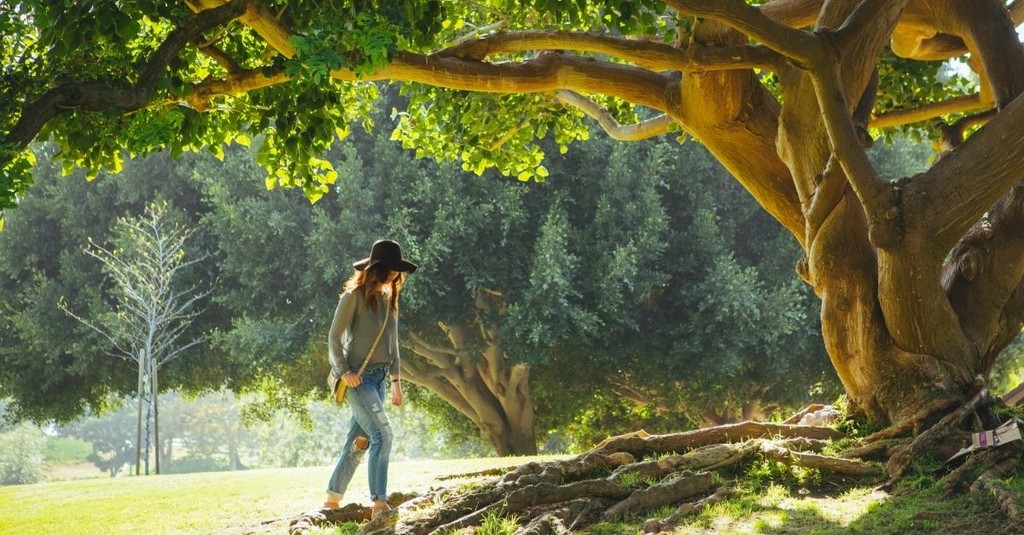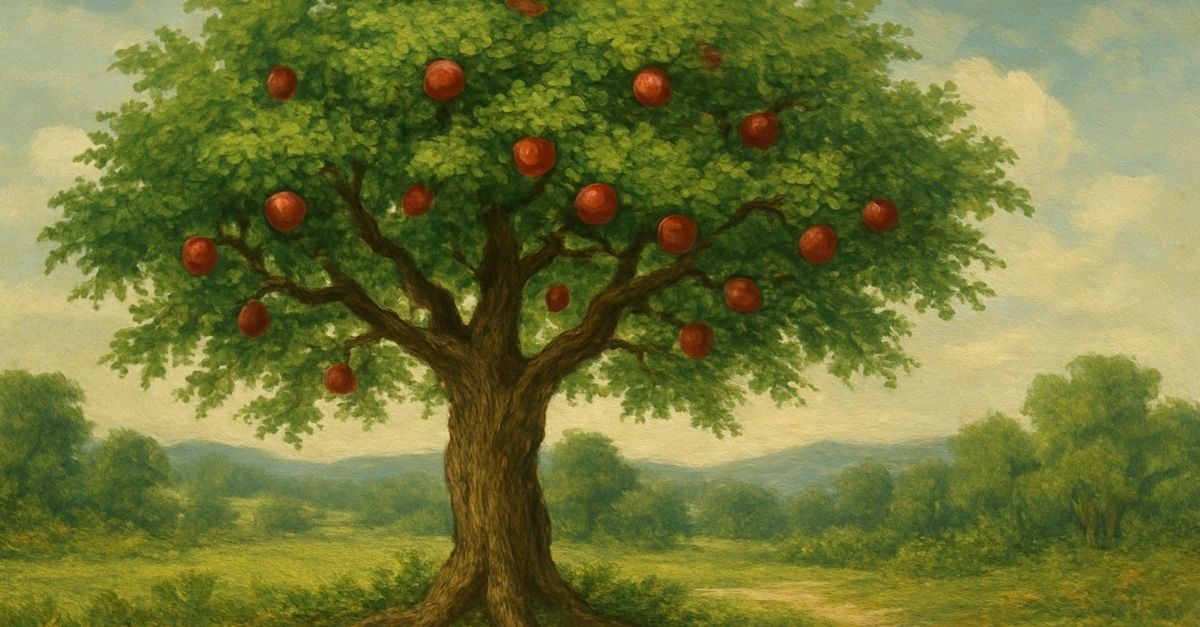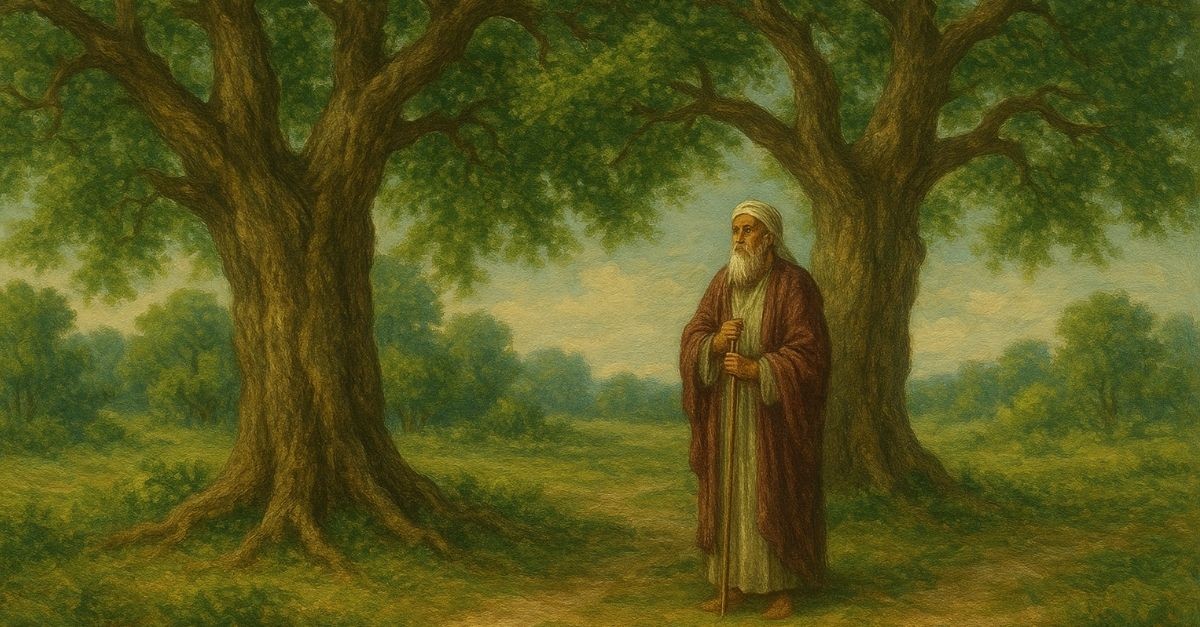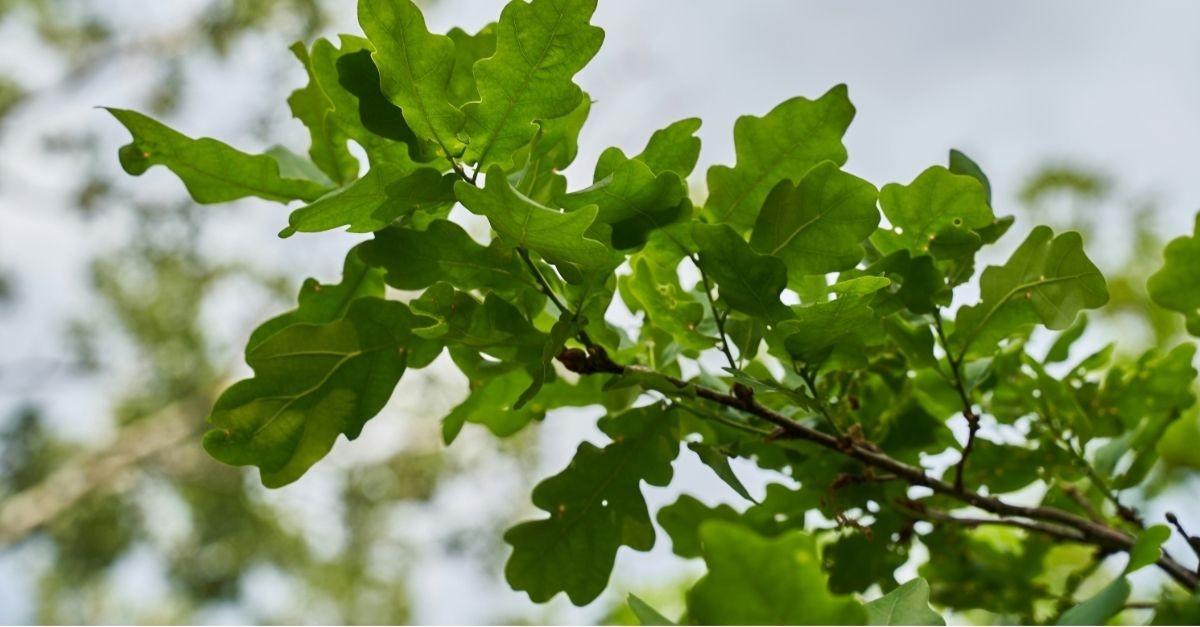
In literature, trees are more than scenery. Anne diligently named the trees surrounding her home in Green Gables, as did another of L. M. Montgomery’s heroines, Emily Starr of New Moon. Many of the trees in fictional worlds are even sentient, such as those within Narnia and Middle-earth, though all have honor as respected plants of nature. They took sides during battle, and many fought for the sake of what is good, true, and beautiful.
How different these literary depictions are from the attitude of the common person. Lots of us pass our gaze indifferently across the thick patch of woods or the sentry trees of our neighborhoods. They are merely part of the environment, another aspect that can be trimmed or chopped down at will. Yet, if we consider biblical teaching, trees have significance. They were often connected to major events in Scripture and have symbolic meaning in reference to kings and kingdoms. Our Lord was crucified on a piece of wood, a fallen tree. Why then do we not look at trees differently? As Andrew Peterson wrote in his book The God of the Garden, “living as we do in our air-conditioned homes, working as many of us do in our offices, it has become far too easy to forget how marvelous a tree really is” (B&H, 2021, p. 40).
By considering the Bible’s teaching about trees and their significance, perhaps we can recapture the sense of how awe-inspiring trees are and allow their beauty to move us to praise God, for He is the Lord and Creator of all, the Savior who was hung on a tree for our sake. Let us consider the following examples and then take another look at that tree outside our house or in the park. It might just look different to us.
Photo Credit: ©Unsplash/Kevin Young

1. Tree of the Knowledge of Good and Evil
In Genesis 2, Scripture tells us that God planted a garden where He placed the first humans (Genesis 2:8). He also made various types of trees grow from the ground, including ones used for fruit as well as ornamental varieties (Genesis 2:9). Far more than only serving a function for the earth, the trees were made as an expression of God’s creativity and a reflection of His beauty. The garden planted by the Lord centered around the tree of life and the tree of the knowledge of good and evil.
Perhaps more than any other tree in history, this tree became a symbol of sin, rebellion, and sin. It was this tree that God told Adam and Eve not to eat from, since it would lead to their death (Genesis 2:16-17). Yet, the old serpent, the devil, convinced them that disobeying God was actually a wise choice. When Eve looked at the fruit of the tree of the knowledge of good and evil, and heard the serpent’s crafty talk, eating from the tree seemed like a good, even preferable, choice: “When the woman saw that the fruit of the tree was good for food and pleasing to the eye, and also desirable for gaining wisdom, she took some and ate it” (Genesis 3:6, NIV). Adam ate the fruit as well, and thus, they both disobeyed the Lord’s instructions.
As a result, the curse of sin and death entered the world, affecting all creation (Romans 5:12, 8:22). God’s good creation had been marred because of Adam and Eve’s sin; nothing would ever be the same again.
The question, though, remains as to why God created this tree. Theologians have debated this throughout history: Why would He place something in the garden that could bring about such devastation? Well, the answer becomes clearer when we consider that there were two trees in the middle of Eden. Adam and Eve could choose to obey God and receive life (the tree of life), or rebel and suffer the consequences of their sins (the tree of the knowledge of good and evil). He gave the first humans the gift of free will, which meant they could love Him without being placed under coercion. But with that freedom to love came the possibility they might turn away from God.
Scripture never speaks again of that tree where Adam and Eve sinned against God. It does, however, speak of the tree of life – but that is for another point.
Photo Credit: AI/ChatGPT

2. The Great Trees of Mamre
When Abram (Abraham) went to live in Canaan, as instructed by God, he pitched his tents under the great trees of Mamre (Genesis 13:18). This was either in or near Hebron, as biblical scholars disagree about the exact location. What is clear is that these trees held significance for the man who would become the father of many nations. He built an altar under the trees in honor of the Lord and often sat in their shade. The trees even became a meeting place where He encountered the Lord.
Three visitors traveled near his camp one day, and Scripture tells us that it was at this time that “The Lord appeared to Abraham near the great trees of Mamre” (Genesis 18:1, NIV). Though the next chapter makes it clear that two of these visitors were angels, some scholars believe the other visitor was the Lord God. He is the One who promised Abraham that he would have a son by the next year and who revealed what was going to happen to Sodom and Gomorrah (Genesis 18:10, 13-14).
There is disagreement of whether these were oak or terebinth trees, since the identification varies depending on the translation (see Genesis 18:1, ESV and NKJV). Regardless of the specific type of tree, God meeting humans under the shade of trees matches His character, for He often walked with Adam and Eve among the plants and trees of Eden in the coolness of the day (Genesis 3:8).
Photo Credit: AI/Chat GPT

3. Palm Trees
Readers of Scripture today might associate palm trees with the ocean, but the Bible provides a multifaceted perspective of the palm.
As the Israelites traveled after their departure from Egypt, they found rest at Elim. Scripture describes this oasis as having twelve springs of water and being surrounded by seventy palm trees (see Exodus 15:27 and Numbers 33:9). After spending time in the wilderness, this lush location would have brought great refreshment to the weary Israelites. God provided them with the rest they needed, thus connecting the tree with divine provision.
Since the Israelites had found refreshment underneath the palm trees, it is not surprising that God incorporated this tree into the festival of tabernacles. He instructed the Israelites to rejoice before him with the branches of trees, including the palm (see Leviticus 23:40). During Nehemiah’s time, after the exiles had returned, Sukkot was reinstituted, and they used palm fronds and other parts of trees to build temporary shelters during the holy feast days (see Nehemiah 8:15).
During the time of the judges, Deborah prophesied and directed the people from under a palm tree (Judges 4:5). Some versions indicate that she held court under the tree, judging cases in the open air for all to hear. From this position, she instructed Barak to meet Sisera in battle because the Lord would deliver the commander into his hands (Judges 4:6-7). Her authority and faithful service to God– even being willing to go to battle–is what made her memorable as a Judge who was known as a mother in Israel (see Judges 5:7).
The association of the palm with refreshment, provision, shelter, and justice provides a suitable basis for why God included this tree in the decoration of the temple. On the walls, doors, and accessories of the temple were the engravings of palm trees (1 Kings 6:29, 32, 35; 7:36). Every time the Israelites gazed on these beautiful carvings, they would have been reminded of God’s presence and care for them.
And, when Jesus entered Jerusalem riding on a donkey and her colt, the people waved palm branches in celebration of His entry (John 12:12-16). He fulfilled the prophecy of the coming of Israel’s king, which served as evidence of His identity as the promised Messiah (Zechariah 9:9). Every Palm Sunday, we remember this event.
Photo Credit: ©Unsplash/Andrew Ridley

4. Cedars of Lebanon
A tree cherished for its wood and aromatic scent, builders highly sought the cedars of Lebanon. So, when Solomon worked on the building of the Lord’s temple, he requested cedars from Hiram, the king of Tyre. Hiram expressed honor to God and thus agreed to furnish Solomon with as much wood as he needed (1 Kings 5:1-12). Using cedar and juniper, Solomon set out to build the great temple.
His goal, of course, was to follow the plans given to him by his father, David, but the wise king also went about his work with an emphasis on beauty and quality. As Scripture tells us, “The inside of the temple was cedar, carved with gourds and open flowers. Everything was cedar; no stone was to be seen” (1 Kings 6:18, NIV). Not only would the temple have had a distinct smell from the earthy-scented cedar, but it was carefully inlaid with the best of wood. What other choice would have befitted the place that symbolized God’s presence with Israel?
In addition to its reputation for quality, the cedars of Lebanon were well-known for their majestic heights and strength. Scripture often includes these trees as significant symbols for kings and kingdoms. Just as the cedar was renowned for its height, kings often rose to power and were referred to by God as cedars. The king of Assyria, for example, was described as an impressive cedar, set apart in majesty from the other trees of Eden. Yet, despite his position and the extent of his kingdom, the king of Assyria, that mighty cedar, was cut down by God–and He warned Egypt of the same fate (see Ezekiel 31:1-18). The only tree, or kingdom, that will endure is the one that grew as if from a small mustard seed–Christ’s Kingdom (Matthew 13:31-32).
Not all references to the cedar of Lebanon, though, are about arrogant kings from the past. The tree is referred to positively when compared to the flourishing that will come to those who follow the Lord (Psalm 92:12). Symbolism surrounding these trees also associate them with eternal life, which is a suitable connection since believers receive eternal life as a gift from God (John 10:28). This tree serves as a strong reminder of our faith and the strength of our Savior.
Photo Credit: ©Unsplash/ Casey Horner

5. Oak Trees
It was under an oak tree that the angel of the Lord talked to Gideon, to rally the uncertain young man to save Israel from the Midianites (Judges 6:11). As in other stories in Scripture, trees often served as places where God appeared to or communicated with people. However, over time, people corrupted this practice and began using trees to engage in idolatry. Truly, Saint Boniface was not the first follower of the Lord to encounter the connection between the worship of false gods and the oak when he cut down a tree (known as the Thunder Oak) used in worship of Thor; the Israelites engaged in spiritual adultery under the spreading limbs of this type of tree long ago.
God spoke through the prophets to condemn the unrighteous actions of those who committed idolatry. He was fully aware of the sexual immorality, human sacrifice, and the worship of false gods that went on under the cover of trees (Isaiah 57:5). As the Lord declared through the prophet Ezekiel: “And they will know that I am the Lord, when their people lie slain among their idols around their altars, on every high hill and on all the mountaintops, under every spreading tree and every leafy oak—places where they offered fragrant incense to all their idols” (Ezekiel 6:13, NIV). The Lord rightly condemned their idolatry.
Lest we think badly of the oak, though, we should note that these trees did serve a purpose in Scripture. It was an oak that caught Absalom, the traitorous son of David, since his long hair snagged in the branches. His undoing ironically came because of his pride and vanity, and he was left exposed in the tree so that Joab eventually killed him (2 Samuel 18:9-18; also see 2 Samuel 14:25-27).
Scripture also attached positive symbolism to the oak when it described the future state of believing Israel, calling them “oaks of righteousness,” since they will bring glory to the Lord through their flourishing (Isaiah 61:3). Although many Israelites misused these trees, and turned their backs to the Lord under them, the image of the oak will be transformed into a symbol of righteousness and justice. The believing Israelites will be a glorious planting for God.
Photo Credit: ©Unsplash/Azimbek Assarov

6. Tree of Life and the Connection to the Cross
The tree of the knowledge of good and evil was only one of two trees that were central in Eden. One brought death, because of sinful disobedience, but the other had the capacity to impart everlasting life. In His mercy, God shielded Adam and Eve from being able to eat of the tree of life, since living forever as a slave to sin is a terrible fate (Genesis 3:22-24). He barred them from the garden to prevent them from causing more harm to themselves.
Yet that tree shows up again in the last book in the Bible. In Revelation, John the Apostle described the tree of life being present in the New Jerusalem, bearing twelve crops of fruit each month and its leaves being used for the healing of the nations (Revelation 22:2). He also recorded the words of the Lord Jesus, that those who “wash their robes” will have the right to eat from the tree of life (Revelation 22:14).
Scholars differ on whether these images are purely symbolic or if they refer to a literal tree that will stand in the New Heaven and New Earth. However, the imagery is clearly connected to the gift offered by Christ. For as it is, the Savior died on the cross, or as other verses say, on a tree, to bring salvation to all who trust in Him. Those who were hung on a tree in the Old Testament were considered accursed (Deuteronomy 21:23). Yet, Jesus became a curse for us to bring us freedom from the law (Galatians 3:13). As 1 Peter 2:24 says, “He himself bore our sins in his body on the tree, that we might die to sin and live to righteousness. By his wounds you have been healed.” (ESV).
The imagery of the tree of life is connected to the cross because it is through eating its fruit (i.e., trusting in Jesus’ sacrificial death and resurrection) that a person receives eternal life. Whereas the tree of the knowledge of good and evil brought sin, the tree of life symbolized the hope of salvation that would come through the Messiah, the seed of woman promised to Eve (Genesis 3:15). Thus, the instrument of death became a symbol of life – the cross.
Trees may seem ordinary to us, their foliage only capturing our attention when the leaves turn golden. Yet, Scripture gives us many different reasons why we should allow the trees to remind us of His love, care, justice, and most of all, the salvation He brought through the death of His Son. Trees are not so ordinary after all.
Related Resource: Study the Book of Daniel with Us This Fall!
What does it look like to live with courage, clarity, and conviction when everything around you feels uncertain? The book of Daniel tells the story of faith under fire—of ordinary people who stayed rooted in God while living in a culture that didn’t share their values. From exile in Babylon to lion’s dens and prophetic dreams, Daniel shows us that small acts of faith can anchor us in uncertain times.
This 12-week journey will help you discover how to live right side up in an upside-down world—with integrity, trust, and unshakable hope. If this episode enables you to know and love God more, be sure to subscribe to the How to Study the Bible Podcast on Apple or Spotify so you never miss an episode!
Photo Credit: ©Unsplash/ Thanti Riess

Originally published Wednesday, 20 August 2025.
